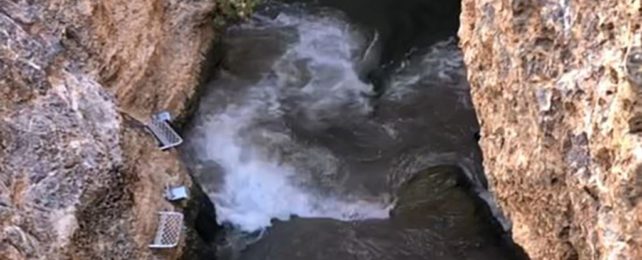Last Monday, September 19, a 7.6 magnitude earthquake shook the Pacific coast of Mexico at 11.05 am local time.
Five minutes later and 2,400 kilometers (1,500 miles) away, a researcher at Death Valley National Park in California noticed something strange.
Biological science technician Ambre Chaudoin was peering down into the famous limestone cavern known as Devils Hole when the usually calm entrance to the desert aquifer began to churn and swirl.
"This is a big earthquake, wherever it is," Chaudoin can be heard saying in the background of her footage.
"I don't think I've ever been here when there was such a large quake."
Soon enough, Chaudoin's voice and the voices of others around her were drowned out by the crashing and sucking of waves, which the US National Park Service (NPS) later announced reached over a meter (4 feet) high at 11.35 am.
Technically, when an earthquake churns up a lake or partially enclosed body of water, it's known as a seiche. But when this occurs in an arid environment like Death Valley National Park, it's colloquially known as a 'desert tsunami'.
While not nearly as giant as an ocean tsunami, these waves are much larger than what is usually seen in this partially filled cavern.
"Devils Hole is a window into this vast aquifer and an unusual indicator of seismic activity around the world," reads an explanation on the NPS website.
"Large earthquakes as far away as Japan, Indonesia and Chile have caused the water to 'slosh' in Devils Hole like water in a bathtub."
These earthquake-triggered waves have previously reached as high as 2 meters, and in these extreme events, the water can drag algae and diatoms off the hole's sunlit shelf.
That can be a serious problem for the hole's isolated population of pupfish, which have been foraging and spawning on the cave's shelf for over 10,000 years.
Today, Devils Hole pupfish (Cyprinodon diabolis) are critically endangered, although their numbers have recently shown signs of recovery.
Nine years ago, there were only 75 pupfish left in the Devils Hole. This year, a formal tally in March reached 175.
It's not yet clear why pupfish in the Devils Hole are suffering. Not every desert tsunami is a deadly event for these creatures, but they are certainly a risk factor given the limited nutrients available in the 152-meter-deep (500 feet) habitat.
Waves in the Devils Hole can actually help the ecosystem, clearing the shelf of organic matter that can deplete the aquifer of oxygen over time.
"This kind of resets the system," Kevin Wilson, an NPS aquatic ecologist, told the LA Times.
But if these waves are powerful enough, they can also wash away too much.
Luckily, no dead pupfish were found after the Mexico earthquake, but it's unclear how much algae the waves washed away or how many fish eggs the splashes may have crushed.
The recent phenomenon is a good reminder that a disaster in one part of the world can very well impact an overlooked ecosystem or species thousands of kilometers away.
